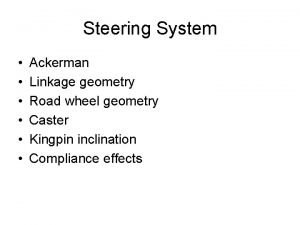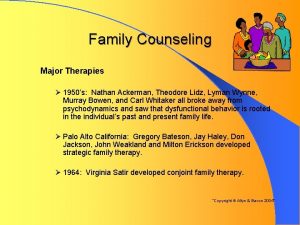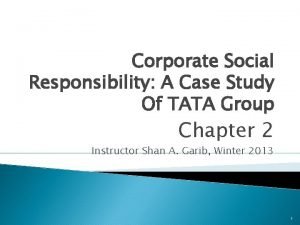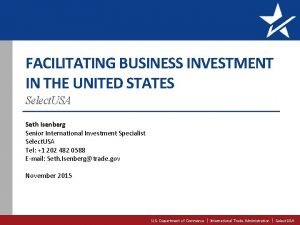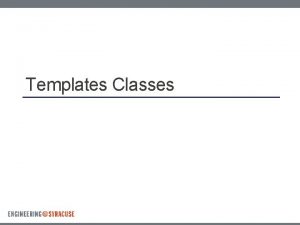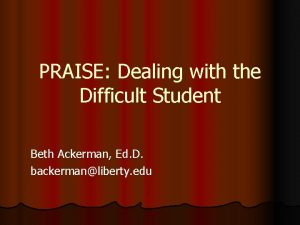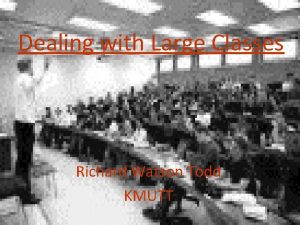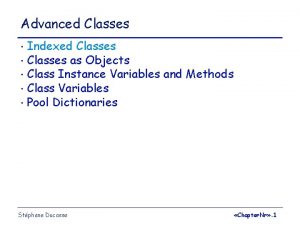Dealing with Large Lecture Classes Steve Ackerman University























- Slides: 23

Dealing with Large Lecture Classes Steve Ackerman University of Wisconsin-Madison

Write down…. • What you know about lecturing or • What opinions you have about lecturing

Objective • To get you to think about, and provide ideas on how to improve your lecture.


Lecture: a discourse given before an audience or class especially for instruction. Discourseverbal interchange of ideas; especially conversation; formal and orderly and usually extended expression of thought on a subject

Misconceptions about the Lecture • • The lecture is boring… The lecture is dead… The three-step formula… Good lecturers are entertainers…

When to use the lecture… • Present broad outlines of a subject and factual information • Set guidelines for assignments • Encourage student interest in a topic • Illustrate problem-solving strategies • Model intellectual attitudes you want to encourage • Brainstorm

Three steps…. • Tell them what you are going to tell them • Then tell them what you’ve told them Then ask them something new, or a question that tells you that they understand…

You don’t have to entertain, but… • You can’t teach them if you don’t have their attention • You never have everyone’s attention all of the time.

Getting and Keeping Attention • Story telling is social and a learning tool • Humor is a social connector • Body language and physical expressions send messages • Pay attention to your physical environment • Never say NO. • The lecture as theatre

The Lecture as Theatre: You are • • • The actor The director The writer The producer The technician Keep in mind………… Shakespeare vs. Gilligan’s Island

What is a good teacher? A good teacher transforms difficult concepts in ways that students can understand through the use of metaphors, analogies, and examples.

Prepare for the ear, not the eye • Speak succinctly in straight forward sentences • Provide transitions, “as we have seen”, “now we can address…” • Periodically summarize key points • Intersperse questions

Trust your instincts • If you know about a disruption, the class knows about it…. • If you think you are boring them, you probably are. – If your delivery is not working, change it.

Don’t read from a script • You’ll be disengaged – not thinking about what you are saying • No eye contact with students • Experiment with different formats for you notes

Structure the lecture • Suit your audience and subject matter • Identify main topics to be covered • Provide a logical progression of material – general principle to specifics, build up from the parts to the whole, describe a problem and illustrate or outline solution • Summarize – make sure students understand

Know your students

One structure…. • • Attention-getting introduction Brief overview of main topics Quick background or context Detailed explanation of major points (no more than three), the most important first • Conclude with summary of main points to reinforce key themes and a question to introduce next topic.

Other thoughts on structure… • Design your lectures in ten or fifteen minute blocks – A block contains a single point, concludes with a summary and transition to the next section… • Include time for questions. • Assess your lecturing

Thoughts about questions… • Include questions at the beginning of the class. • Try not to ask questions that you know the students know that you know they know the answer to. • Give students time to answer your question. • Questions for groups – brainstorming questions – draw a picture.

Resistance to learning. . . • Apparent Irrelevance of the Activity • Poor self-image as learners • Fear of the unknown (the routine, habit and familiarity are appealing to some) • Lack of Clarity in teacher’s instruction • Dislike of Teacher • Difference in Learning and Teaching Styles • Fear of Looking Foolish • Level is Inappropriate

Evaluate your lecturing • Peer review • Video tape a lecture • Get student feedback – Quizzes, Board of directors • Make notes after your lecture – What worked, what didn’t • Assessment of students – Know what you want to learn about

Notes on Management • • • Be organized 10, 000 pieces of paper Take advantage of campus resources Office hours and e-mail Class size doesn’t linear scale with management
 Steve jobs, steve wozniak and ronald wayne
Steve jobs, steve wozniak and ronald wayne Quanto classe e subclasse
Quanto classe e subclasse Pre ap classes vs regular classes
Pre ap classes vs regular classes 01:640:244 lecture notes - lecture 15: plat, idah, farad
01:640:244 lecture notes - lecture 15: plat, idah, farad Bendavid classification
Bendavid classification Ackerman percentage
Ackerman percentage Steering geometry error
Steering geometry error Ackerman family therapy
Ackerman family therapy Dr akkerman dave
Dr akkerman dave Ackerman's model of csr
Ackerman's model of csr Ackerman electric
Ackerman electric Norman ackerman
Norman ackerman Population resource region by ackerman
Population resource region by ackerman Raymond ackerman academy
Raymond ackerman academy Www.craigslist.com los angeles
Www.craigslist.com los angeles Susan pojer
Susan pojer Keida ackerman
Keida ackerman Steve jobs commencement address
Steve jobs commencement address Branch of linguistics dealing with meaning
Branch of linguistics dealing with meaning What is abiotic factor
What is abiotic factor Section 2 dealing with other nations
Section 2 dealing with other nations Call center stress
Call center stress Market follower
Market follower It is genre of speculative fiction dealing with imaginative
It is genre of speculative fiction dealing with imaginative





